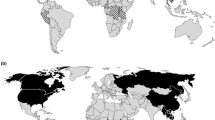Abstract
More than 70% of zoonotic diseases are wildlife associated putting wildlife professionals at increased risk of occupational exposure. In 2008 and 2018, the Arizona Department of Health Services surveyed Arizona wildlife professionals from multiple agencies to assess the risk of disease exposure, rabies pre-exposure prophylaxis (PrEP) history, personal protective equipment (PPE) use, and zoonoses knowledge. In 2008, a 12-question survey was distributed at a state wildlife professional meeting using an anonymous email link. In 2018, a 20-question survey was distributed using an anonymous email link to wildlife agency employees. We received 164 and 81 complete responses in the 2008 and 2018 surveys, respectively. Bites from rabies reservoir or spillover species were higher in 2008 (42%) than in 2018 (16%). More respondents received PrEP in 2018 (53%) than in 2008 (45%). Among 43 respondents who performed necropsies or collected animal samples within the past 5 years (2014–2018), only 60% always wore latex or nitrile gloves, and 79% never wore a facemask. Respondents indicated lower awareness of certain zoonoses, including brucellosis (72%) and leptospirosis (60%). Results on zoonoses awareness and reasons for non-use of PPE highlighted targets for education to improve practices, including facilitation of PPE training to prevent future disease transmission.



Similar content being viewed by others
Change history
19 March 2020
The original version of the article unfortunately contained a typo error in second author name in the author group. The author name was incorrectly published as “Jesse Grewal” and the correct name is “Jessie Grewal”.
References
Arizona Department of Health Services (2018) Rabies—data, publication, and maps. https://www.azdhs.gov/preparedness/epidemiology-disease-control/rabies/#data-publications-maps. Accessed August 15, 2018.
Arizona Department of Health Services (2019) Infectious disease epidemiology 2010–2015 report. https://www.azdhs.gov/documents/preparedness/epidemiology-disease-control/disease-data-statistics-reports/infectious-disease-epidemiology-report-2010-2015.pdf. Accessed January 17, 2019.
Baker WS, Gray GC (2009) A review of published reports regarding zoonotic pathogen infection in veterinarians. J Am Vet Med Assoc 234(10):1271–1278.
Bosch SA, Musgrave K, Wong D (2013) Zoonotic disease risk and prevention practices among biologists and other wildlife workers–results from a national survey, US National Park Service, 2009. J Wildl Dis 49(3):475–585.
Callahan A, Ames NJ, Manning ML, Touchton-Leonard K, Yang L, Wallen R (2016) Factors Influencing Nurses’ Use of Hazardous Drug Safe-Handling Precautions. Oncol Nurs Forum 43(3):342–349.
Centers for Disease Control and Prevention (2011) Preexposure vaccinations. https://www.cdc.gov/rabies/specific_groups/travelers/pre-exposure_vaccinations.html. Accessed January 10, 2019.
Garland-Lewis G, Whittier C, Murray S, Trufan S, Rabinowitz PM (2017) Occupational risks and exposures among wildlife health professionals. Ecohealth 14(1):20–28.
Hanisch-Kirkbride SL, Riley SJ, Gore ML (2013) Wildlife disease and risk perception. J of Wildlife Diseases 49(4):841–849.
Johnston JD, Eggett D, Johnson MJ, Reading JC (2014) The influence of risk perception on biosafety level-2 laboratory workers’ hand-to-face contact behaviors. J Occup Environ Hyg 11(9):625–632.
Jones KE, Patel NG, Levy MA, Storeygard A, Balk D, Gittleman JL, Daszak P (2008) Global trends in emerging infectious diseases. Nature 451(7181):990–993.
Lombardi DA, Verma SK, Brennan MJ, Perry MJ (2009) Factors influencing worker use of personal protective eyewear. Accid Anal Prev 41(4):755–762.
Mauldin MR, Doty JB, Nakazawa Y, Emerson GL, Carroll DS (2016) The importance of mammalogy, infectious disease research, and biosafety in the field. Manter (Linc) 3.
Miller JM, Astles R, Baszler T, Chapin K, Carey R, Garcia L, Gray L, Larone D, Pentella M, Pollock A et al (2012) Centers for disease control and prevention. Guidelines for safe work practices in human and animal medical diagnostic laboratories. Recommendations of a CDC-convened, biosafety blue ribbon panel. MMWR Suppl 61(1):1–102.
National Park Service (2009) National park service occupational safety and health program; reference manual 50B. https://www.nps.gov/policy/RM50Bdoclist.htm.
Rupprecht CE, Briggs D, Brown CM, Franka R, Katz SL, Kerr HD, Lett SM, Levis R, Meltzer MI, Schaffner W, et al (2010) Use of a reduced (4-dose) vaccine schedule for postexposure prophylaxis to prevent human rabies: recommendations of the advisory committee on immunization practices. Morbidity and Mortality Weekly Report 59(2):1–9.
Vitek CR, Ksiazek TG, Peters CJ, Breiman RF (1996) Evidence against infection with hantaviruses among forest and park workers in the southwestern United States. Clin Infect Dis 23(2):283–285.
Williams CJ, Cheftel JM, Elchos BL, Hopkins SG, Levine JF, and National Association for State Public Health Veterinarians (2015) Compendium of veterinary standard precautions for zoonotic disease prevention in veterinary personnel. J Am Vet Med Assoc 247:1252–1277.
Wong D, Wild MA, Walburger MA, Higgins CL, Callahan M, Czarnecki LA, Lawaczeck EW, Levy CE, Patterson JG, Sunenshine R, et al (2009) Primary pneumonic plague contracted from a mountain lion carcass. Clin Infect Dis 49(3):e33–38.
Acknowledgments
We thank Anne Justice-Allen, Chasa O’Briean, Lisa Shender, and the Arizona Game and Fish Department, David Bergman (USDA, APHIS, Wildlife Services), Kenneth Komatsu, Sonya Shannon, Caleb Wiedeman, and the Arizona Department of Health Services, Brant Goode, John Gibbins, Jessica Rinsky, and the Centers for Disease Control and Prevention, and Yue Qui and Arizona State University. This study was funded as part of normal routine activities by the Arizona Department of Health Services and Centers for Disease Control and Prevention.
Author information
Authors and Affiliations
Corresponding author
Additional information
Disclaimer: The findings and conclusions in this report are those of the authors and do not necessarily represent the official position of the U.S. Centers for Disease Control and Prevention or the U.S. Department of Health and Human Services.
Rights and permissions
About this article
Cite this article
Tarrant, S., Grewal, J., Yaglom, H. et al. Zoonotic Disease Exposure Risk and Rabies Vaccination Among Wildlife Professionals. EcoHealth 17, 74–83 (2020). https://doi.org/10.1007/s10393-020-01469-w
Received:
Revised:
Accepted:
Published:
Issue Date:
DOI: https://doi.org/10.1007/s10393-020-01469-w




